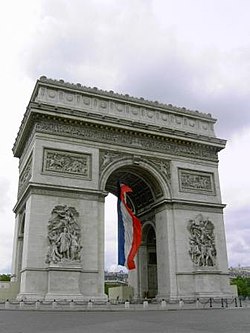Arc de Triomphe

The Arc de Triomphe is an iconic Triumphal arch in Paris, France that stands in the centre of the Place Charles de Gaulle, also known as the Place de l'Étoile (Star Square). It is at the western end of the Champs-Élysées. The arch honours those who fought for France, particularly during the Napoleonic Wars. On the inside and the top of the arc there are all of the names of generals and wars fought. Underneath is the tomb of the unknown soldier from World War I.
The Arc is the linchpin of the historic axis (L'Axe historique) — a sequence of monuments and grand thoroughfares on a route which goes from the courtyard of the Louvre Palace to the outskirts of Paris. The monument was designed by Jean Chalgrin in 1806, and its iconographic program pitted heroically nude French youths against bearded Germanic warriors in chain mail and set the tone for public monuments, with triumphant nationalistic messages, until World War I.
The monument stands 49.5 metres (165 ft) in height, 45 metres (148 ft) wide and 22 meters (72 ft) deep. It is the second largest triumphal arch in existence (replaced in 1982 by a North Korean arch of triumph).[1] Its design was inspired by the Roman Arch of Titus. The Arc de Triomphe is so colossal that three weeks after the Paris victory parade in 1919, marking the end of hostilities in World War I, Charles Godefroy flew his Nieuport biplane through it, with the event captured in a newsreel
History
The Arc de Triomphe is one of the most famous monuments in Paris. It was commissioned in 1806 after the victory at Austerlitz by Emperor Napoleon at the peak of his fortunes. Laying the foundations alone took two years, and in 1810 when Napoleon entered Paris from the west with his bride Archduchess Marie-Louise of Austria, he had a wooden mock-up of the completed arch constructed. The architect Jean Chalgrin died in 1811, and the work was taken over by Huyon. During the Restoration, construction was halted and would not be completed until the reign of King Louis-Philippe, in 1833–36 when the architects on site were Goust, then Huyot, under the direction of Héricart de Thury. Napoleon's body passed under it on 15 December 1840 on its way to its second and final resting place at Les Invalides


